Physical Address
304 North Cardinal St.
Dorchester Center, MA 02124
| Abdominal diameter | AD |
| American College of Obstetricians and Gynecologists | ACOG |
| Amniotic fluid index | AFI |
| Anteroposterior | AP |
| Biparietal diameter | BPD |
| Cerebral palsy | CP |
| Combined spinal-epidural | CSE |
| Computed tomography | CT |
| Confidence interval | CI |
| External cephalic version | ECV |
| Fetal heart rate | FHR |
| Internal podalic version | IPV |
| Magnetic resonance imaging | MRI |
| Occipitofrontal diameter | OFD |
| Occiput posterior | OP |
| Odds ratio | OR |
| Perinatal mortality rate | PMR |
| Periventricular leukomalacia | PVL |
| Preterm premature rupture of membranes | PPROM |
| Relative risk | RR |
| Term Breech Trial | TBT |
Near term or during labor, the fetus normally assumes a vertical orientation, or lie, and a cephalic presentation, with the flexed fetal vertex presenting to the pelvis ( Fig. 17.1 ). However, in approximately 3% to 5% of singleton gestations at term, an abnormal lie, presentation, or flexed attitude occurs; such deviations constitute fetal malpresentations. The word malpresentation suggests the possibility of adverse consequences, and malpresentation is often associated with increased risk to both the mother and the fetus. In the early 20th century, malpresentation often led to a variety of maneuvers intended to facilitate vaginal delivery, including destructive operations leading, predictably, to fetal death. Later, manual or instrumented attempts to convert the malpresenting fetus to a more favorable orientation were devised. Internal podalic version (IPV) followed by a complete breech extraction was once advocated as a solution to many malpresentation situations. However, like with most manipulative efforts to achieve vaginal delivery, in many circumstances IPV was associated with high fetal and maternal morbidity and mortality rates and has been largely abandoned.
In general, factors associated with malpresentation include (1) diminished vertical capacity of the uterine cavity, (2) increased or decreased fetal mobility, (3) obstructed pelvic inlet, (4) fetal malformation, and (5) prematurity. The association of great parity with malpresentation is presumably related to laxity of maternal abdominal musculature and resultant loss of the normal vertical orientation of the uterine cavity. Placentation low in the pelvis ( Fig. 17.2 ) is another factor that diminishes the likelihood of a fetus assuming a longitudinal axis. Uterine myomata, intrauterine synechiae, and müllerian duct fusion abnormalities such as a septate uterus or uterine didelphys are similarly associated with a higher than expected rate of malpresentation. Because both prematurity and polyhydramnios permit increased fetal mobility, the probability of a noncephalic presentation is greater if preterm labor or rupture of the membranes occurs. Furthermore, preterm birth involves a fetus that is small relative to the maternal pelvis; therefore engagement and descent with labor or rupture of the membranes can occur despite a malpresentation. In contrast, conditions such as chromosomal aneuploidies, congenital myotonic dystrophy, joint contractures from various etiologies, arthrogryposis, oligohydramnios, and fetal neurologic dysfunction that result in decreased fetal muscle tone, strength, or activity are also associated with an increased incidence of fetal malpresentation. Finally, the cephalopelvic disproportion associated with severe fetal hydrocephalus or with a contracted maternal pelvis may be implicated as an etiology of malpresentation because normal engagement of the fetal head is prevented.
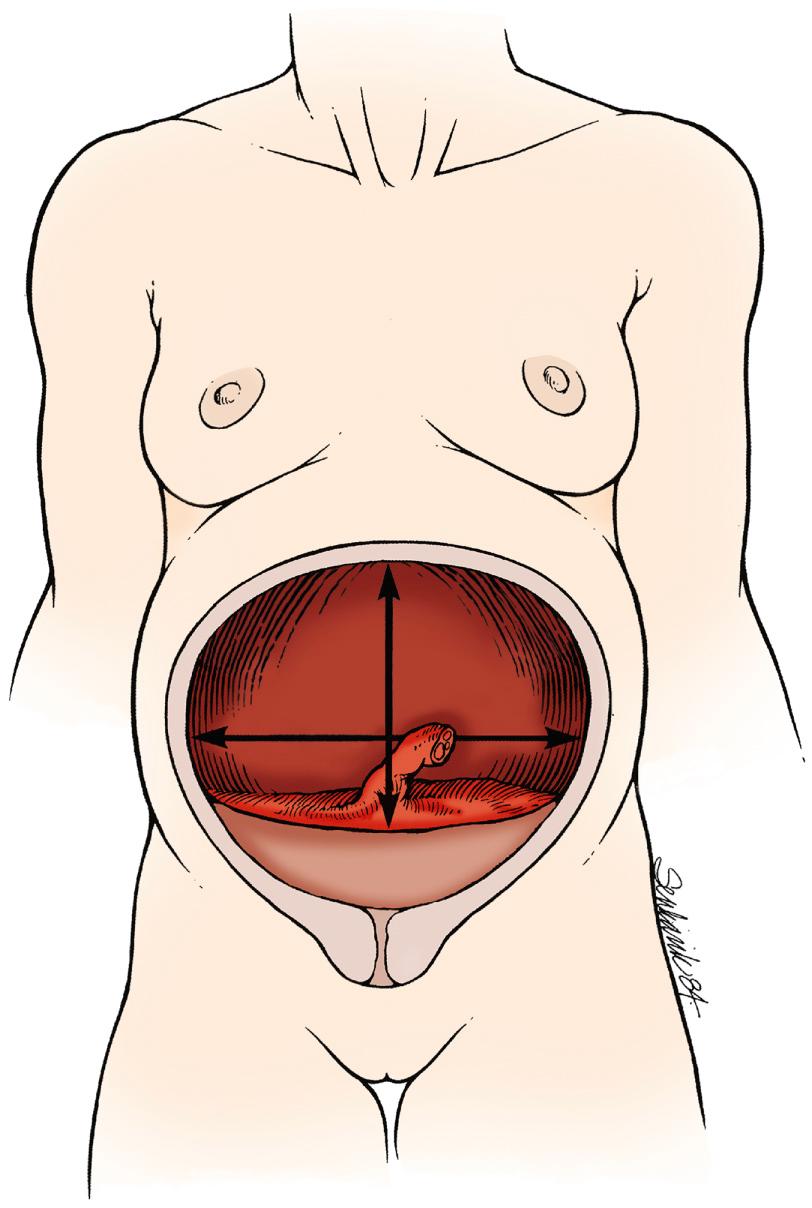
The fetal lie indicates the orientation of the fetal spine relative to the spine of the mother. The normal fetal lie is longitudinal and by itself does not indicate whether the presentation is cephalic or breech. If the fetal spine or long axis crosses that of the mother, the fetus may be said to occupy a transverse or oblique lie ( Fig. 17.3 ), which may cause an arm, foot, or shoulder to be the presenting part ( Fig. 17.4 ). The lie may be termed unstable if the fetal membranes are intact and fetal mobility is increased, which results in frequent changes of lie and/or presentation.
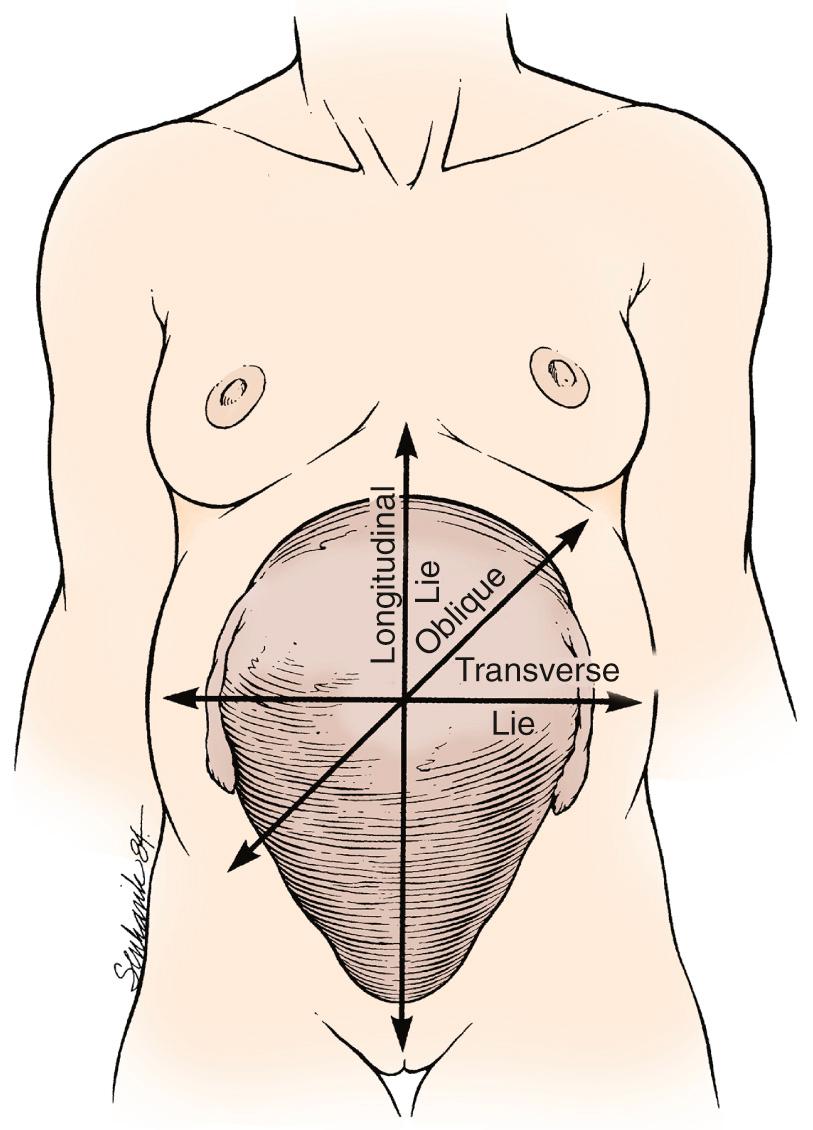
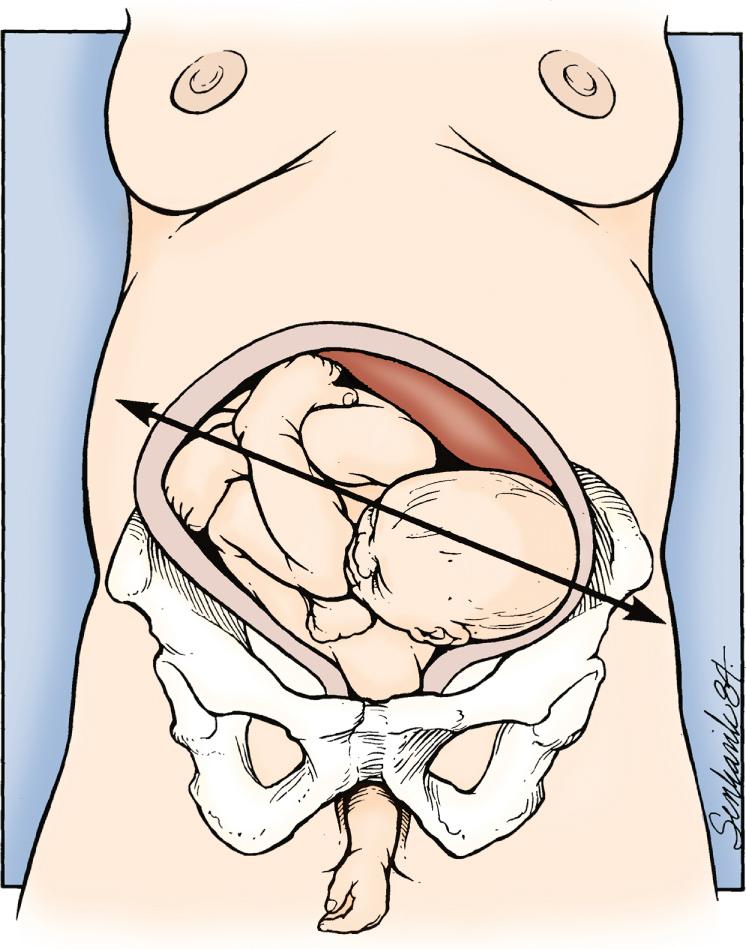
Abnormal fetal lie is diagnosed in approximately 1 in 300 cases, or 0.33% of pregnancies at term. Prematurity is often a factor, with abnormal lie reported to occur in approximately 2% of pregnancies at 32 weeks’ gestation—six times the rate found at term. Persistence of a transverse, oblique, or unstable lie beyond 37 weeks’ gestation requires a systematic clinical assessment and a plan for management; this is because rupture of the membranes without a fetal part filling the inlet of the pelvis poses an increased risk of cord prolapse, fetal compromise, and maternal morbidity if neglected.
As noted, great parity, prematurity, contraction or deformity of the maternal pelvis, and abnormal placentation are the most commonly reported clinical factors associated with abnormal lie; however, it often happens that none of these factors are present. In fact, any condition that alters the normal vertical capacity of the intrauterine cavity will predispose to abnormal lie.
Diagnosis of the abnormal lie may be made by palpation using Leopold maneuvers or by vaginal examination verified by ultrasound. Although routine use of Leopold maneuvers may be helpful, Thorp and colleagues found the sensitivity of Leopold maneuvers for the detection of malpresentation to be only 28% and the positive predictive value was only 24% compared with immediate ultrasound verification. Others have observed prenatal detection in as few as 41% of cases before labor. Adaptations have been made to the Leopold maneuvers that may improve detection of an abnormal lie or presentation. The Sharma modified Leopold maneuver and the Sharma right and left lateral maneuvers in the original report demonstrated improved diagnostic accuracy; they detected vertex presenting occipitoanterior (95% vs. 84.4%, P = .04), posterior presentations (96.3% vs. 66.6%, P = .00012), and breech presentations correctly more often than with traditional Leopold maneuvers. These maneuvers use the forearms in addition to the hands and fingers. As with any abdominal palpation technique, limitations on accuracy are to be expected in the obese patient and in a patient with uterine myomata. The ready availability of ultrasound in most clinical settings is of benefit, and its use can obviate the vagaries of the abdominal palpation techniques. In all situations, early diagnosis of malpresentation is of benefit . A reported fetal loss rate of 9.2% with an early diagnosis, versus a loss rate of 27.5% with a delayed diagnosis, indicates that early diagnosis improves fetal outcome.
Reported perinatal mortality rates (PMRs) for unstable or transverse lie (corrected for lethal malformations and extreme prematurity) vary from 3.9% to 24%, with maternal mortality as high as 10%. Maternal deaths are usually related to infection after premature rupture of membranes, hemorrhage secondary to abnormal placentation, complications of operative intervention for cephalopelvic disproportion, or traumatic delivery. Fetal loss of phenotypically and chromosomally normal gestations at ages considered to be viable is primarily associated with delayed interventions, prolapsed cord, or traumatic delivery. Cord prolapse occurs 20 times as often with abnormal lie as it does with a cephalic presentation.
Safe vaginal delivery of a fetus from an abnormal axial lie is not generally possible. A search for the etiology of the malpresentation is always indicated. A transverse/oblique or unstable lie late in the third trimester necessitates ultrasound examination to exclude a major fetal malformation and abnormal placentation. Fortunately, most cases of major fetal anomalies or abnormal placentation can currently be diagnosed long before the third trimester. Phelan and colleagues reported 29 patients with transverse lie diagnosed at or beyond 37 weeks’ gestation and managed expectantly, and 83% (24 of 29) spontaneously converted to breech (9 of 24) or vertex (15 of 24) before labor; however, the overall cesarean delivery rate was 45%, with two cases of cord prolapse, one uterine rupture, and one neonatal death. Hankins and colleagues compared the outcomes of 14 mother-infant pairs found to be in a transverse lie at 37 weeks to 28 breech and 28 vertex controls matched for gestational age, route of delivery, and the presence of labor. Newborn outcomes for those with a transverse lie were significantly worse, including more with severe acidosis (3 of 14 vs. 1 of 56, P = .04) and more with significant birth trauma (5 of 14 vs. 1 of 28 breech, P = .01 and 2 of 28 vertex, P = .03). External cephalic version (ECV) is recommended at 36 to 37 weeks to help diminish the risk of adverse outcome, and failing this, cesarean is recommended at 38 weeks. There is no place for IPV and breech extraction in contemporary management of transverse or oblique lie or in an unstable presentation in a potentially viable singleton pregnancy because of the unacceptably high rate of fetal and maternal complications.
A persistent abnormal axial lie, particularly if accompanied by ruptured membranes, also alters the choice of uterine incision at cesarean delivery. A low transverse (Kerr) uterine incision has many surgical advantages and is generally the preferred approach for cesarean delivery for an abnormal lie (see Chapter 19 ). Because up to 25% of transverse incisions may require vertical extension for delivery of an infant from an abnormal lie, and the lower uterine segment is often poorly developed and insufficiently broad such that atraumatic delivery of the presenting part is made more difficult, other uterine incisions may be considered. A “J” or “T” extension of the low transverse incision results in a uterine scar that is more susceptible to subsequent rupture due to poor vascularization. Therefore in the uncommon case of a transverse or oblique lie with a poorly developed lower uterine segment, when a transverse incision is deemed unfeasible or inadequate, a vertical incision (low vertical or classical) may be a reasonable alternative. A vertical uterine incision is also preferred to facilitate extraction of the fetus in the setting of a “back down” transverse lie as determined by preoperative ultrasound. Intraoperative cephalic version may allow the use of a low transverse incision, but ruptured membranes or oligohydramnios may make this difficult. Uterine relaxing agents such as inhalational anesthetics or intravenous nitroglycerin may improve success of these maneuvers if the difficulty is attributable to a contracted uterine fundus.
Attitude refers to the position of the fetal head in relation to the neck. The normal attitude of the fetal head during labor is one of full flexion with the fetal chin against the upper chest. Deflexed attitudes include various degrees of deflection or even extension of the fetal neck and head ( Fig. 17.5 ), leading to, for example, face or brow presentations. Spontaneous conversion to a more normal, flexed attitude or further extension of an intermediate deflection to a fully extended position commonly occurs as labor progresses owing to resistance exerted by the bony pelvis and soft tissues. Although safe vaginal delivery is possible in many cases, experience indicates that cesarean delivery may be the most appropriate alternative when arrest of progress is observed.
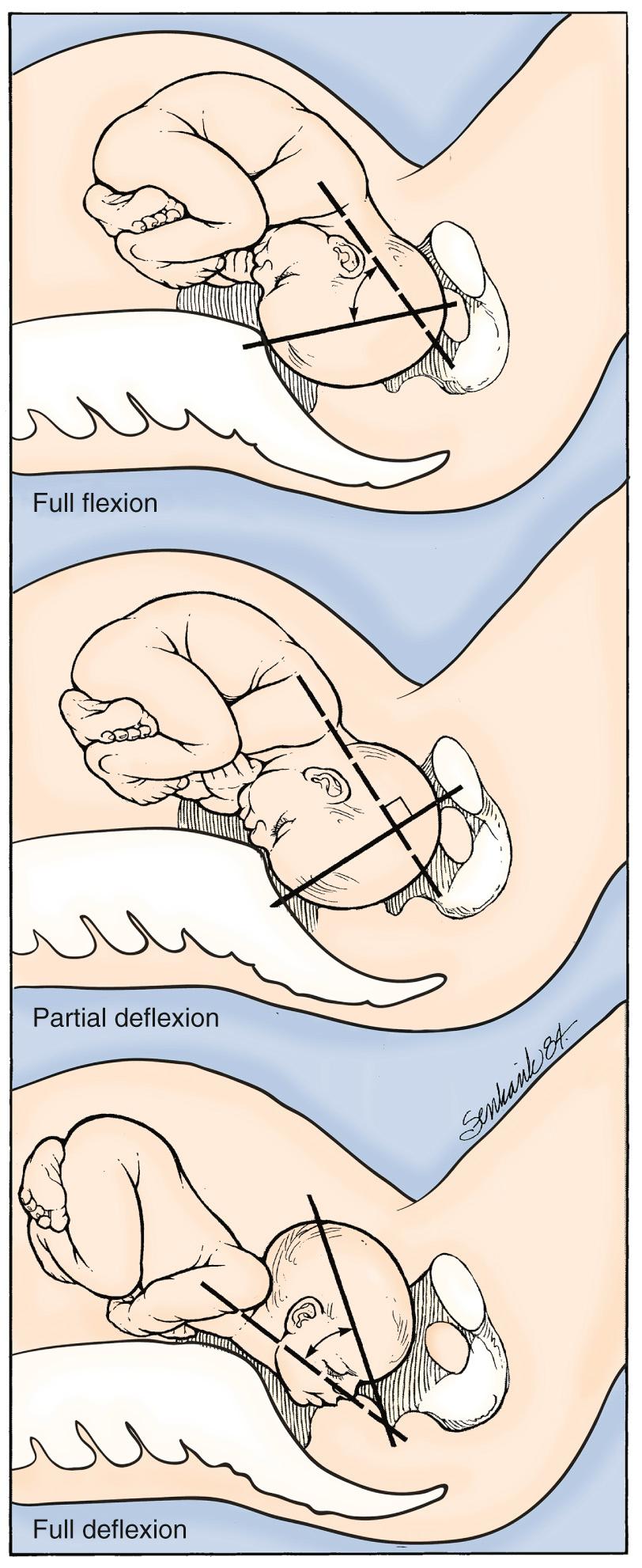
A face presentation is characterized by a longitudinal lie and full extension of the fetal neck and head with the occiput against the upper back ( Fig. 17.6 ). The fetal chin (mentum) is chosen as the point of designation during vaginal examination . For example, a fetus presenting by the face and whose chin is in the right posterior quadrant of the maternal pelvis would be called a right mentum posterior ( Fig. 17.7 ). The reported incidence of face presentation ranges from 0.14% to 0.54% and averages approximately 0.2%, or 1 in 500 live births overall. The reported PMR, corrected for nonviable malformations and extreme prematurity, varies from 0.6% to 5% and averages approximately 2% to 3%.
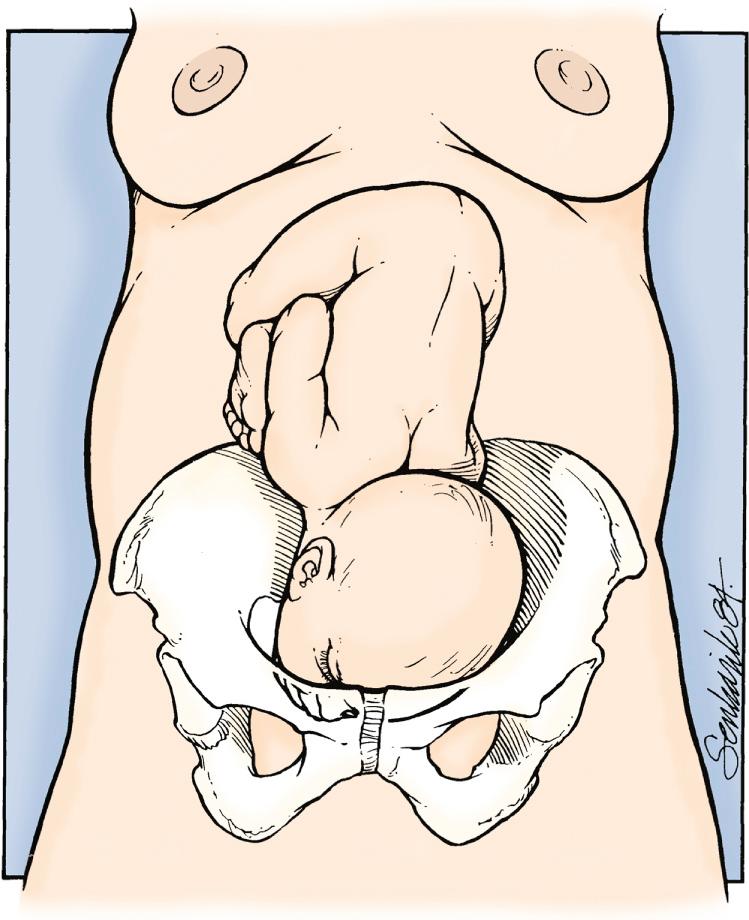
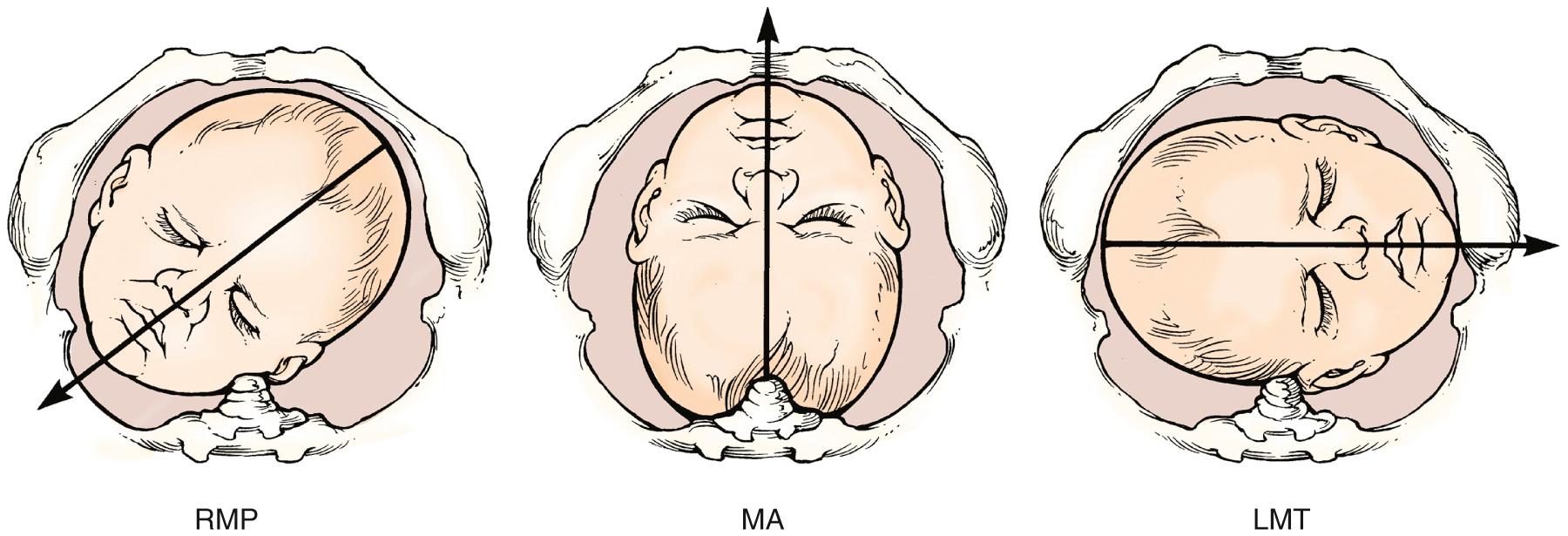
All clinical factors known to increase the general rate of malpresentation have been implicated in face presentation; many infants with a face presentation have malformations. Anencephaly, for instance, is found in approximately one-third of cases of face presentation. Fetal goiter and tumors of the soft tissues of the head and neck may also cause deflexion of the head. Frequently observed maternal factors include a contracted pelvis or cephalopelvic disproportion in 10% to 40% of cases. In a review of face presentation, Duff found that one of these etiologic factors was found in up to 90% of cases.
Early recognition of the face presentation is important, and the diagnosis can be suspected when abdominal palpation finds the fetal cephalic prominence on the same side of the maternal abdomen as the fetal back ( Fig. 17.8 ); however, face presentation is more often discovered by vaginal examination. In practice, fewer than 1 in 20 infants with face presentation is diagnosed by abdominal examination. In fact, only half of these infants are found by any means to have a face presentation before the second stage of labor, and half of the remaining cases are undiagnosed until delivery. However, perinatal mortality may be higher with late diagnosis.
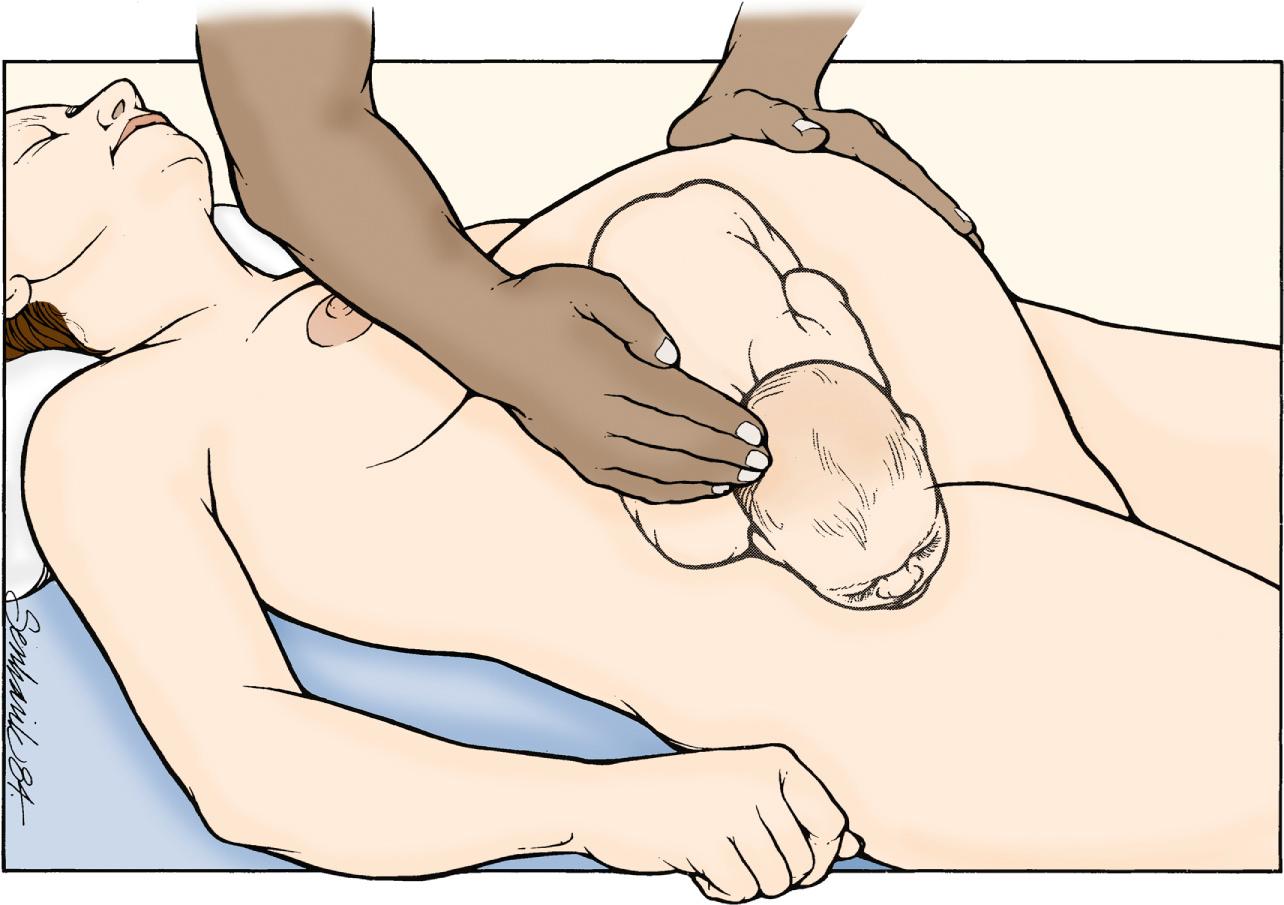
Knowledge of the early mechanism of labor for face presentation is incomplete. Many infants with a face presentation probably begin labor in the less extended brow position. With descent into the pelvis, the forces of labor press the fetus against maternal tissues; subsequent flexion (to a vertex presentation) or full extension of the head on the spine (to a face presentation) then occurs. The labor of a face presentation must include engagement, descent, internal rotation generally to a mentum anterior position, and delivery by flexion as the chin passes under the symphysis ( Fig. 17.9 ). However, flexion of the occiput may not always occur, and delivery in the fully extended attitude may be common.
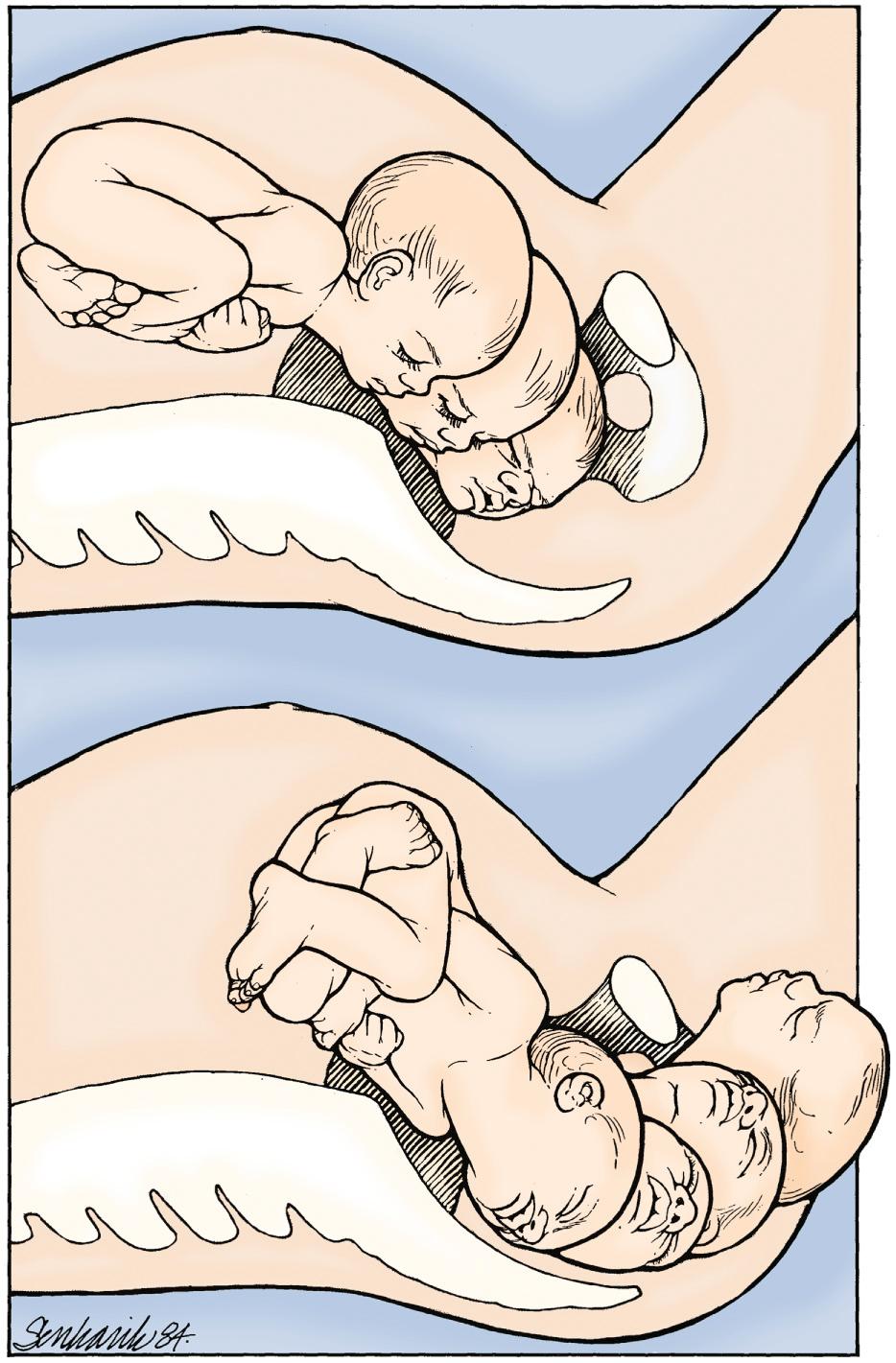
The prognosis for labor with a face presentation depends on the orientation of the fetal chin. At diagnosis, 60% to 80% of infants with a face presentation are mentum anterior, 10% to 12% are mentum transverse, and 20% to 25% are mentum posterior. Almost all average-sized infants presenting mentum anterior with adequate maternal pelvic dimensions will achieve spontaneous or assisted vaginal delivery. Furthermore, most mentum transverse infants will rotate to the mentum anterior position and will deliver vaginally, and even 25% to 33% of mentum posterior infants will rotate and deliver vaginally in the mentum anterior position. In a review of 51 cases of persistent face presentation, Schwartz and colleagues found that the mean birthweight of those infants in a mentum posterior position who did rotate and deliver vaginally was 3425 g, compared with 3792 g for those infants who did not rotate and deliver vaginally. However, persistence of the mentum posterior position with an infant of normal size makes safe vaginal delivery less likely. Overall, 70% to 80% of infants with a face presenting can be delivered vaginally, either spontaneously or by low forceps in the hands of a skilled operator, whereas 12% to 30% require cesarean delivery. Manual attempts to convert the face to a flexed attitude or to rotate a posterior position to a more favorable mentum anterior position are rarely successful and increase both maternal and fetal risks.
Prolonged labor is a common feature of face presentation and has been associated with an increased number of intrapartum deaths ; therefore prompt attention to an arrested labor pattern is recommended. In the case of an average or small fetus, an adequate pelvis, and hypotonic labor, oxytocin may be considered. No absolute contraindication to oxytocin augmentation of hypotonic labor in face presentations exists, but an arrest of progress despite adequate labor should call for cesarean delivery.
Worsening of the fetal condition in labor is common. Several observers have found that abnormal fetal heart rate (FHR) patterns occur more often with face presentation. Continuous intrapartum electronic FHR monitoring of a fetus with face presentation is considered mandatory, but extreme care must be exercised in the placement of an electrode because ocular or cosmetic damage is possible. If external Doppler heart rate monitoring is inadequate and an internal electrode is recommended, placement of the electrode on the fetal chin is often preferred.
Contraindications to vaginal delivery of a face presentation include macrosomia, nonreassuring FHR monitoring even without arrested or protracted labor, or an inadequate maternal pelvis; cesarean delivery has been reported in as many as 60% of cases of face presentation for these reasons. If cesarean delivery is warranted, care should be taken to flex the head gently, both to accomplish elevation of the head through the hysterotomy incision as well as to avoid potential cervical nerve damage to the neonate. Forced flexion may also result in fetal injury, especially with fetal goiter or neck tumors.
Fetal laryngeal and tracheal edema that results from the pressure of the birth process might require immediate nasotracheal intubation. Nuchal tumors or simple goiters, fetal anomalies that might have caused the malpresentation, require expert neonatal management, including the possibility of an ex utero intrapartum treatment procedure, which establishes a fetal/neonatal airway before the umbilical cord is clamped. Identification of and planning for these particular circumstances in the prelabor setting are ideal.
Become a Clinical Tree membership for Full access and enjoy Unlimited articles
If you are a member. Log in here